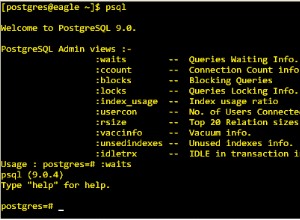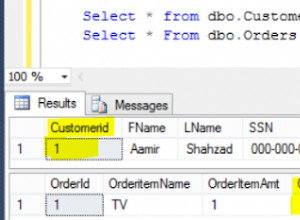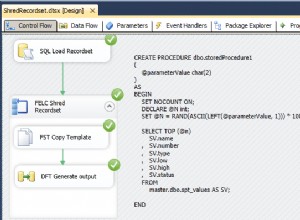Ich glaube nicht, dass Sie Aggregatfunktionen im ON DUPLICATE
. MySQL sieht Ihr SQL ungefähr so:
insert into report_count_assets
expr
on duplicate key update
...
Das ON DUPLICATE weiß nicht, was in expr vor sich geht , weiß es nur, dass es eine einzelne doppelte Zeile zu behandeln hat. Ohne zu wissen, was in expr vor sich geht , gibt es keinen Kontext für count s zu operieren. Außerdem sollten Sie values verwenden im UPDATE:
Und values(count(x)) ist keine gültige Syntax. Aber values(column_name) gültig ist, also sollte das funktionieren:
INSERT INTO report_count_assets
(product_id, asset_count, asset_type_image, asset_type_video, asset_type_sound, asset_type_install)
SELECT products.product_id,
count(product_assets.asset_id),
count(case when assets.asset_type_id=1 THEN 1 END),
count(case when assets.asset_type_id=2 THEN 1 END),
count(case when assets.asset_type_id=3 THEN 1 END),
count(case when assets.asset_type_id=11 THEN 1 END)
FROM products
LEFT JOIN product_assets USING (product_id)
LEFT JOIN assets USING (asset_id)
WHERE products.brand_id=671
ON DUPLICATE KEY UPDATE
asset_count = values(asset_count),
asset_type_image = values(asset_type_image),
asset_type_video = values(asset_type_video),
asset_type_sound = values(asset_type_sound),
asset_type_install = values(asset_type_install);
Ich musste den Namen der product_id erraten Spalte in report_count_assets .
Wenn das nicht funktioniert (was anscheinend nicht der Fall ist), können Sie es auf die harte Tour machen, indem Sie SELECT vorab berechnen. Erstellen Sie eine temporäre Tabelle:
create temporary table t (
product_id int,
product_count int,
assets1 int,
assets2 int,
assets3 int,
assets11 int
)
Füllen Sie es aus:
INSERT INTO t (product_id, product_count, assets1, assets2, assets3, assets11)
SELECT products.product_id,
count(product_assets.asset_id),
count(case when assets.asset_type_id=1 THEN 1 END),
count(case when assets.asset_type_id=2 THEN 1 END),
count(case when assets.asset_type_id=3 THEN 1 END),
count(case when assets.asset_type_id=11 THEN 1 END)
FROM products
LEFT JOIN product_assets USING (product_id)
LEFT JOIN assets USING (asset_id)
WHERE products.brand_id=671
Und dann verwenden Sie diese temporäre Tabelle, um die Einfügung durchzuführen, die Sie wirklich tun möchten:
insert into report_count_assets
select product_id, product_count, assets1, assets2, assets3, assets11
from t
on duplicate key update
asset_count = values(product_count),
asset_type_image = values(assets1),
asset_type_video = values(assets2),
asset_type_sound = values(assets3),
asset_type_install = values(assets11)




